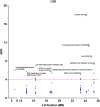Bulk segregant RNA-seq reveals expression and positional candidate genes and allele-specific expression for disease resistance against enteric septicemia of catfish
- PMID: 24373586
- PMCID: PMC3890627
- DOI: 10.1186/1471-2164-14-929
Bulk segregant RNA-seq reveals expression and positional candidate genes and allele-specific expression for disease resistance against enteric septicemia of catfish
Abstract
Background: The application of RNA-seq has accelerated gene expression profiling and identification of gene-associated SNPs in many species. However, the integrated studies of gene expression along with SNP mapping have been lacking. Coupling of RNA-seq with bulked segregant analysis (BSA) should allow correlation of expression patterns and associated SNPs with the phenotypes.
Results: In this study, we demonstrated the use of bulked segregant RNA-seq (BSR-Seq) for the analysis of differentially expressed genes and associated SNPs with disease resistance against enteric septicemia of catfish (ESC). A total of 1,255 differentially expressed genes were found between resistant and susceptible fish. In addition, 56,419 SNPs residing on 4,304 unique genes were identified as significant SNPs between susceptible and resistant fish. Detailed analysis of these significant SNPs allowed differentiation of significant SNPs caused by genetic segregation and those caused by allele-specific expression. Mapping of the significant SNPs, along with analysis of differentially expressed genes, allowed identification of candidate genes underlining disease resistance against ESC disease.
Conclusions: This study demonstrated the use of BSR-Seq for the identification of genes involved in disease resistance against ESC through expression profiling and mapping of significantly associated SNPs. BSR-Seq is applicable to analysis of genes underlining various performance and production traits without significant investment in the development of large genotyping platforms such as SNP arrays.
Figures









Similar articles
-
GWAS analysis using interspecific backcross progenies reveals superior blue catfish alleles responsible for strong resistance against enteric septicemia of catfish.Mol Genet Genomics. 2018 Oct;293(5):1107-1120. doi: 10.1007/s00438-018-1443-4. Epub 2018 May 8. Mol Genet Genomics. 2018. PMID: 29737402
-
Allelically and Differentially Expressed Genes After Infection of Edwardsiella ictaluri in Channel Catfish as Determined by Bulk Segregant RNA-Seq.Mar Biotechnol (NY). 2022 Mar;24(1):174-189. doi: 10.1007/s10126-022-10094-3. Epub 2022 Feb 15. Mar Biotechnol (NY). 2022. PMID: 35166964
-
Genome-wide association analysis of intra-specific QTL associated with the resistance for enteric septicemia of catfish.Mol Genet Genomics. 2018 Dec;293(6):1365-1378. doi: 10.1007/s00438-018-1463-0. Epub 2018 Jul 2. Mol Genet Genomics. 2018. PMID: 29967962
-
GWAS analysis of QTL for enteric septicemia of catfish and their involved genes suggest evolutionary conservation of a molecular mechanism of disease resistance.Mol Genet Genomics. 2017 Feb;292(1):231-242. doi: 10.1007/s00438-016-1269-x. Epub 2016 Nov 8. Mol Genet Genomics. 2017. PMID: 27826737
-
The NCK and ABI adaptor genes in catfish and their involvement in ESC disease response.Dev Comp Immunol. 2017 Aug;73:119-123. doi: 10.1016/j.dci.2017.03.016. Epub 2017 Mar 22. Dev Comp Immunol. 2017. PMID: 28341353
Cited by
-
Bulked Segregant RNA Sequencing Revealed Difference Between Virulent and Avirulent Brown Planthoppers.Front Plant Sci. 2022 Apr 14;13:843227. doi: 10.3389/fpls.2022.843227. eCollection 2022. Front Plant Sci. 2022. PMID: 35498688 Free PMC article.
-
Identification of genes regulated by histone acetylation during root development in Populus trichocarpa.BMC Genomics. 2016 Feb 4;17:96. doi: 10.1186/s12864-016-2407-x. BMC Genomics. 2016. PMID: 26847576 Free PMC article.
-
A predicted NEDD8 conjugating enzyme gene identified as a Capsicum candidate Rf gene using bulk segregant RNA sequencing.Hortic Res. 2020 Dec 1;7:210. doi: 10.1038/s41438-020-00425-7. eCollection 2020. Hortic Res. 2020. PMID: 35051251 Free PMC article.
-
Identification of Candidate Genes Associated With Hypoxia Tolerance in Trachinotus blochii Using Bulked Segregant Analysis and RNA-Seq.Front Genet. 2021 Dec 14;12:811685. doi: 10.3389/fgene.2021.811685. eCollection 2021. Front Genet. 2021. PMID: 34970306 Free PMC article.
-
Applying genetic technologies to combat infectious diseases in aquaculture.Rev Aquac. 2023 Mar;15(2):491-535. doi: 10.1111/raq.12733. Epub 2022 Sep 5. Rev Aquac. 2023. PMID: 38504717 Free PMC article. Review.
References
Publication types
MeSH terms
LinkOut - more resources
Full Text Sources
Other Literature Sources
Medical

